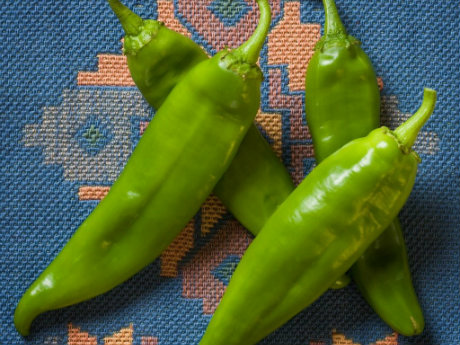Hatch Green Chile grows some heirloom varieties and also commercial chiles for wholesale. The heirlooms include the 6-4, Big Jim and Sandia. “Most of our wholesale business uses the more commonly grown commercial varieties like the Arizona 88 (hot), or 1904 (mild),” he says. They also provide higher yield and consistent, milder heat. It’s the heirlooms that are the hottest.
Good crop expected
A very good crop is expected. “We haven’t had a bad crop or a bad weather year here in a very long time,” states Mitchell. “We produce great chile here and as long as the weather holds we’ll have wonderful chile ready for our customers.” All chiles are grown in the certified Hatch Valley region. “It’s something that in the marketplace has gotten a special cache – if it comes from the Hatch Valley of southern New Mexico it’s kind of a step above the rest.”
The Valley is becoming to chiles what Napa Valley is to wine, but there’s always competition from Mexico’s chiles. “What we’re marketing – this is a niche product,” Mitchell says. To be called Hatch it needs to be grown in the Hatch Valle of southern New Mexico. The New Mexico Chile Association is in the process of finalizing its federal certification mark.” That mark is found on our boxes and that’s what proves it’s actual Hatch chile from the Hatch Valley.” There have been some complications with the certification itself. He says a company out of state, which produces a processed chile product, has opposed the certification and they are in litigation.

All of the chile grown in the Hatch Valley qualifies for the certification mark. “We continue to license it to growers who grow chile here in the Hatch Valley. I can’t speak to where they source their chile. That’s been the subject of debate and discovery for over three years.”
Hatch Green Chile continues to grow for the fresh pack business as well as roasted/frozen business. In places where it can’t be found locally or if customers want to be sure they’re getting certified Hatch chiles they would order online.
In the past pricing was affected by programs that Mitchell says didn’t necessarily care about building long-term relationships with customers. The market would get blown out with produce at very low prices. “I think the price situation has firmed up a little in the last few years. We’ve seen a correction in that situation. The biggest packers are realizing industry need to firm up pricing and make sure growers are paid well.”
Hatch chiles are hugely versatile “Everyone does Hatch chile flame roasted. How you roast the chile is very important in terms of what sort of flavor you get out of it.” Even the roasting events themselves make people stop to look – and Mitchell says many people will drive 50 miles just to get some. “ You’d be surprised how many people will see an ad (for a chile roaster event) and they’ll drive 50 miles to buy five to six sacks of roasted chiles.” Retailers are more often than not sell out 10 times more than what they expect to sell, according to Mitchell. His customer base is all over country: direct to consumer across US, Europe, japan, Australia, Canada, some into South America and wholesale to Texas and California. “More and more grocers are starting to realize the customer does want Hatch chile. (Customers) want it to be available the same way they can (purchase) Vidalia onion in season.”





